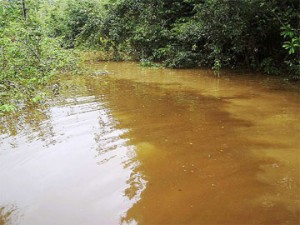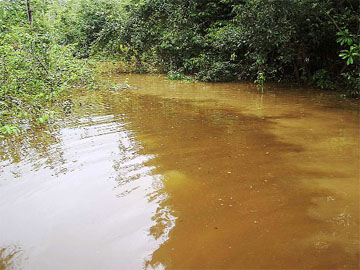
The PM, who holds the portfolio for mining, also admitted that the Guyana Geology and Mines Commission (GGMC) needed to increase its monitoring staff. “We do need to increase our mines officers,” Hinds told reporters at a press conference at the GGMC library yesterday adding that he recognized a need for more rangers.
Acting Commissioner of the GGMC, William Woolford said plans were ongoing to take up the slack and with 33 rangers in place seven more were needed to provide a working number. He noted that some are expected to graduate from the University of Guyana shortly and stated too that the Environmental Division of the regulatory body was slated for expansion.
Hinds said the time for educating and encouraging miners had passed and sanctions would be applied to those in breach of regulations. He said he wanted to encourage a new relationship between the media and the mining sector adding that some criticisms were not helpful. He further stated with regard to the environmental situation, that there was a mixed situation with eight out of ten miners “doing reasonably well”.
Meantime, noting that increasing numbers of persons have been entering the gold-mining sector, the PM said it had moved into a new situation, with new people doing new things for the first time with unintended consequences. In this light, he said, action had been taken but not highlighted. “We’ve been having contentions, we’ve been having sanctions but we’ve been largely keeping it within the sector,” he said. He pointed out that programmes by the Canadian International Develop-ment Agency (CIDA) and the World Wildlife Fund (WWF) to raise small and medium-scale miners to a “higher level” had been held. He said it was a challenge to stay abreast of the 10,000 operators in the sector.
However, the Prime Minister said work was ongoing to ensure miners operated within the mining rules and pointing to the 30 NTU (turbidity units) required for water to be discharged into waterways noted that new rules were being introduced as required. Referring to a report published in yesterday’s Stabroek News, in which a miner said he used a green leaf to capture mercury vapour, he said it was unacceptable that miners were still doing that. “Anyone doing that will certainly be sanctioned,” he said.
He declared that the miner who was doing this had “no excuse… he should be sanctioned and sanctioned severely”.
Woolford said that with respect to mercury use, after a period of warning, sanctions were being applied.
Regarding turbidity and the level of muddiness in waterways, Hinds, said the GGMC was at a stage where operations would be stopped, once this happened. He said increased pressure was being applied to operations that committed breaches and “significant sanctions” had been taken out against those found doing so.
Asked about Brazilians in the industry, the PM said that he would “guesstimate” that of 10,000 persons directly employed in the small and medium-scale mining sector, 1,000 were Brazilians. He emphasized that small and medium-scale mining properties were owned by Guyanese.
Om the issue of restoration of mined lands, Hinds pointed out that formerly this was largely dependent on natural regeneration, and this was a new area and in the early stages locally. He said it was an issue that had to be addressed. Currently $100,000 and $200,000, depending on the size of the operation had to be lodged by small and medium-scale miners as environmental bonds and the PM said he did not think this was enough. He said it was the responsibility of the property holder to ensure that reclamation and restoration of mined out areas was done but posited that this could be done at the end of mining in the area as one exercise.
Meanwhile, questioned about aspects of the mining regulations not being enforced, the Prime Minister said this should be insisted upon.
Woolford said that the “GGMC insists on responsible mining, we go around and we warn miners”. He said dozens of persons had been charged and many others operating in other mining areas cited.
Meanwhile, the Prime Minister said that a large increase has been seen in gold declaration locally.
Asked about the smuggling of gold and diamonds, he said that it was more a matter of policing and customs, though the regulatory body was interested.
With regard to corruption, Woolford admitted that some officers were not confirming to “standard operating procedures” and there were four cases pending with those involved being sent on leave.
Hinds admitted that while there was corruption, before taking action, evidence was needed. He said that the sector was important but that would not close their eyes to what some do.
Other officials of the GGMC attended the press conference including Chairman of the GGMC Board, Ronald Webster, who, noting that Guyana was one of the few countries where there was a strong small-scale mining sector, said there was concern as regards responsible mining. He said there was a need to get the small-scale mining industry to self-regulate.






